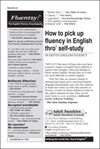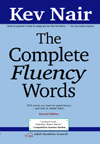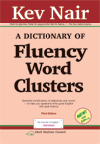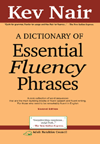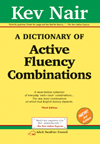How to avoid these mistakes in English
COMPREHENSIVE FLUENT-ENGLISH USAGE™
When you speak or write English, do you make many mistakes? Do you often fail to use words and word-groups in the way in which they’re currently used in English?
In fact, almost everyone makes some mistake or other -- at some time or other. This is a fact. Most advanced learners do. Even expert-level users of English sometimes do. Yes, almost everyone tends to make mistakes. This happens especially when they use words and word groups in particular contexts. Only, some people make fewer mistakes, and others, more.
These mistakes take several forms: Many people tend to use words and phrases in ways that modern English usage does not accept as correct or proper. Many give words and phrases meanings that are different from their meanings in current usage. Many go against the currently accepted grammar of those words and phrases. Many use two or more words together in ways that are considered unacceptable in current usage. Many use word combinations that the current usage considers unacceptable. Many confuse one word with another.
Why you should avoid these mistakes
1). These mistakes prevent the English you speak or write from being accepted as good English.
2). And worse, these mistakes prevent you from being clear to your listeners or readers -- because the listeners and readers expect words and phrases to carry only those meanings that the current usage has assigned to them. And they expect only those words to be used together that sound right (according to the current usage) when used together.
3). And there’s yet another problem. If you’re not sure of the principles of current usage, you’ll run into a serious difficulty: Suppose you’re in the middle of saying something or writing something. And suppose a doubt comes up in your mind whether it’s acceptable to put words together in a particular way. Then this is what happens: Your attention gets diverted from what you’re saying or writing -- to the language you’re using to compose it. That is, you’re now concerned not about the content, but about the form. And you lose the thread of what you’re saying or writing. And the result? The flow of your speech or writing gets cut off -- slowed down. And you falter. And all this makes it difficult for you to remain fluent.
How correct usage helps you communicate effectively
The tips on usage I’ll be posting here have two related aims:
(i) To make you become aware of the common usage-related mistakes -- mistakes that even highly educated people tend to make in English; and
(ii) To tell you how to avoid those mistakes.
Study these notes carefully. And don’t let the lack of awareness of current English usage prevent you from speaking and writing English fluently. And accurately, clearly and effectively. That is, as accurately, as clearly and as effectively as the situation needs -- and permits.
English Usage Tip for the week
Posted on March 04, 2020
Copyright © Kev Nair 2020. All rights reserved.
“damage” OR “damages”?: What’s the correct usage?
Mind you, in certain contexts, damage (without an ‘s’) alone is right; but in certain other contexts, damages (with an ‘s’) alone is right. Let’s look at what these contexts are.
Damage (without an ‘s’)
When somebody/ something does some kind of physical harm to something, like breaking it or injuring it or spoiling it, that thing becomes less valuable, less useful or less attractive. This harm may also make it stop functioning normally or properly.
This physical harm is called “damage” (without an ‘s’).
Last night’s storm has done extensive damage to property around that place.
There was an accident on the way; but the car has suffered only minimal damage.
This is criminal/ malicious damage. Who caused it?
The flood has caused widespread property damage.
The harmful, detrimental or unpleasant effects of an event or action on somebody or something is also called “damage” (without an ‘s’).
Who is answerable for the emotional/ psychological damage done to her?
Has all this caused irreparable damage to the relationship between the two countries?
It was a head injury, wasn’t it? Has he suffered any brain damage?
I don’t think these events can cause any damage to their domestic/ national/ internal economy.
He was speaking about the damage done by all this to his reputation.
Mind you, when it is used in the above-mentioned senses, the word “damage” is an Uncount word. That is, you cannot use it as a singular noun or as a plural noun – to express the above-mentioned meanings.
In other words, the form of the word must be “damage” (without an ‘s') itself. And you must not say or write “damages” (with an ‘s’) or “a damage” (with an ‘a’ before it) – to express the above-mentioned meanings.
Damages (with an ‘s’)
However, there’s one situation in which the term “damages” (with an ‘s’) is used. Yes, this term “damages” (with an ‘s’) is a plural word. But take note of this: The term “damages” (with an ‘s’) has a meaning that is far removed from the meanings of “damage” (without an ‘s') we’ve looked at – though that meaning [of “damages” (with an ‘s’)] is related to the core meaning of “damage” (without an ‘s') we saw above.
Now, what does the term “damages” (with an ‘s’) mean?
Suppose that A harms B or B’s property or injures B’s reputation or causes some kind of a loss to him. And suppose that B proceeds against A in a court of law. The court might then pass an order directing A to pay a certain sum of money to B.
The term “damages” (with an ‘s’) means this money. This means that, essentially, the term “damages” refers to the monetary equivalent of the harm suffered by B, which B can claim from A.
The driver was ordered to pay damages of Rs.50,000/- to the person he knocked down on the road.
How much did the court award them as damages?
We’re suing the company for damages.
The workers have decided to recover the damages incurred by them from their employers.
I can’t say whether the other party is liable for damages in this case.
…
Copyright © Kev Nair 2020. All rights reserved.
Archives: Prof. Kev Nair's
Tips on English Usage
To read the previously posted Tips on English Usage, please provide your full name and your email address.
Access to the archives is completely FREE. There are no charges at all.
